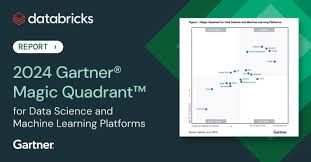
Navigating the Magic Quadrant for Data Science and Machine Learning Platforms
The Magic Quadrant for Data Science and Machine Learning Platforms
In the ever-evolving landscape of data science and machine learning, the Magic Quadrant is a powerful tool that provides valuable insights into the leading platforms in the industry. Developed by Gartner, a renowned research and advisory company, the Magic Quadrant evaluates vendors based on their completeness of vision and ability to execute.
The Magic Quadrant categorizes vendors into four quadrants: Leaders, Challengers, Visionaries, and Niche Players. Each quadrant represents a different combination of a vendor’s vision for the future and their current market performance.
Leaders in the Magic Quadrant are considered to have a strong ability to execute their vision. These vendors typically offer comprehensive platforms with advanced features and capabilities. They have a proven track record of success in delivering innovative solutions to meet the needs of data scientists and machine learning practitioners.
Challengers are vendors that have a solid ability to execute but may lack some elements of vision compared to Leaders. They often provide reliable platforms with robust features but may need to further develop their strategies for future growth.
Visionaries are vendors that demonstrate a strong vision for the future but may face challenges in executing that vision effectively. They are known for pushing boundaries and introducing innovative ideas that have the potential to shape the industry in new ways.
Niche Players are vendors that focus on specific market segments or niche areas within data science and machine learning. While they may excel in certain aspects, they may not offer as broad a range of capabilities as Leaders or Challengers.
Overall, the Magic Quadrant serves as a valuable resource for businesses looking to evaluate data science and machine learning platforms. By considering both a vendor’s vision for the future and their current performance, organisations can make informed decisions about which platform best suits their needs.
Understanding the Magic Quadrant for Data Science and Machine Learning Platforms: Key FAQs
- What is the Magic Quadrant for data science and machine learning platforms?
- How are vendors evaluated in the Magic Quadrant?
- What do the four quadrants (Leaders, Challengers, Visionaries, Niche Players) represent in the Magic Quadrant?
- Who creates and publishes the Magic Quadrant report?
- How can businesses use the Magic Quadrant to choose a data science and machine learning platform?
What is the Magic Quadrant for data science and machine learning platforms?
The Magic Quadrant for data science and machine learning platforms is a renowned evaluation tool developed by Gartner to assess and categorise vendors based on their completeness of vision and ability to execute. This widely referenced framework helps businesses navigate the complex landscape of data science and machine learning by providing insights into the leading platforms in the industry. By categorising vendors into four quadrants – Leaders, Challengers, Visionaries, and Niche Players – the Magic Quadrant offers valuable guidance for organisations seeking innovative solutions and strategic partnerships in the realm of data science and machine learning.
How are vendors evaluated in the Magic Quadrant?
Vendors in the Magic Quadrant for data science and machine learning platforms are evaluated based on two key criteria: their completeness of vision and their ability to execute. Gartner assesses vendors’ vision by looking at their understanding of market trends, innovation, and how they anticipate and respond to customer needs. The ability to execute is measured by evaluating the vendors’ product capabilities, market responsiveness, customer experience, sales execution, and overall business viability. By considering these factors, Gartner positions vendors within the Magic Quadrant to provide a comprehensive view of the competitive landscape in the data science and machine learning platform market.
What do the four quadrants (Leaders, Challengers, Visionaries, Niche Players) represent in the Magic Quadrant?
The four quadrants in the Magic Quadrant for data science and machine learning platforms—Leaders, Challengers, Visionaries, and Niche Players—represent different profiles of vendors based on their vision for the future and their current market performance. Leaders are positioned as having a strong ability to execute their vision with comprehensive platforms and innovative solutions. Challengers demonstrate solid execution capabilities but may lack some visionary elements compared to Leaders. Visionaries showcase forward-thinking ideas but may face challenges in executing them effectively. Niche Players focus on specific market segments or niche areas within the industry, offering specialised capabilities that cater to unique needs. Each quadrant provides valuable insights into how vendors are positioned in terms of both vision and performance within the competitive landscape of data science and machine learning platforms.
Who creates and publishes the Magic Quadrant report?
The Magic Quadrant report for data science and machine learning platforms is created and published by Gartner, a renowned research and advisory company. Gartner is widely respected for its expertise in evaluating technology trends and providing valuable insights into various industries. The Magic Quadrant report is a comprehensive assessment that categorises vendors based on their completeness of vision and ability to execute, helping businesses make informed decisions when selecting data science and machine learning platforms.
How can businesses use the Magic Quadrant to choose a data science and machine learning platform?
Businesses can leverage the Magic Quadrant as a strategic tool to guide their decision-making process when selecting a data science and machine learning platform. By carefully examining the positioning of vendors within the quadrants based on their completeness of vision and ability to execute, businesses can gain valuable insights into the strengths and weaknesses of each platform. This enables companies to make informed choices that align with their specific requirements and goals. The Magic Quadrant provides a structured framework for evaluating vendors, helping businesses identify leaders in the industry who offer comprehensive solutions, as well as niche players who may cater to more specialised needs. Ultimately, by utilising the Magic Quadrant effectively, businesses can streamline their selection process and choose a platform that best supports their data science and machine learning initiatives.
